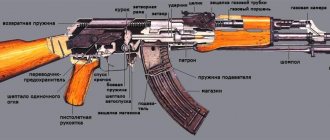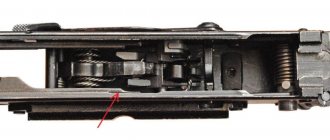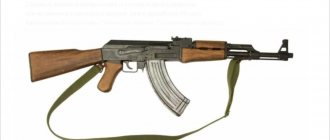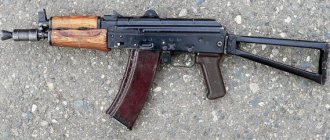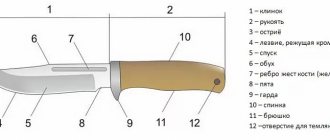The Kalashnikov assault rifle was and remains the most famous automatic weapon today. For defense, it is used not only in the Russian army, but also by the armed forces of other countries around the world. The production of this unique weapon began in the 50s of the last century. It is believed that in total more than 50 million of these weapons were produced, using various modifications. Today we will get acquainted with the history of the Kalashnikov assault rifle and find out why its popularity is manifested.
How the first Kalashnikov assault rifle appeared
The history of the development of the first Kalashnikov assault rifle began with the study of the German MKb.42(H) assault rifle by the Technical Council in 1943. This model used 7.92×33 mm caliber cartridges for firing (the same ammunition was used in the M1 rifle), and was also distinguished by high combat characteristics and an excellent reliability indicator. Soviet engineers were faced with the question of creating similar weapons for the Soviet army, but first of all, it was necessary to develop a universal cartridge.
After several attempts to create a single ammunition, the engineers settled on a 7.62x39 mm caliber projectile. The developers of this cartridge were designers B.V. Semin and N.M. Elizarov. Soon, the development of the first machine gun chambered for 7.62 mm, which was called AS-44, began. Despite the fact that the model passed all army tests, the military “rejected” it, recommending that engineers simplify the overly complex design. However, the death of engineer Sudaev suspended development.
However, the Soviet army still needed weapons chambered for a universal cartridge, so it was decided to hold a competition among engineering teams, as a result of which each group had to present its own model of an assault rifle. According to the results of the competition, the AK-46 won, but the military also considered it unsuitable and sent it for revision. After “bringing it to mind”, the machine gun began to meet all the requirements of the army and entered mass production at the Izhevsk Machine-Building Plant).
The technical solutions and layout of the AK-47 turned out to be very similar to those features that were present in the German MP-38 submachine gun designed by Schmeisser. However, Mikhail Alekseevich Kalashnikov spent his entire life trying to create a real legend from his model. For more than 60 years, the engineer improved the weapon and tried to simplify its design. After Kalashnikov's death in 2013, other engineers continued his work, releasing modern modifications of the AK, for example, the AK-12 and AK-15.
How the AK-47 and AKS were created
In order to modify the rejected AK-47, the group of Kalashnikov and Zaitsev had to go to Izhevsk to ask for help from the German designers working at the plant. Among the team of specialists was the famous German engineer Hugo Schmeisser, who designed a huge number of assault and automatic weapons that were successfully used during the Second World War. Of course, now many will deny the fact that Kalashnikov could collaborate with the Germans, but too many facts speak of this:
- Initially, the AK-47 was created with a wooden stock, but Mikhail Kalashnikov suddenly decided to completely revise the design of the model, installing a polymer stock on it. Subsequently, a similar version was supplied to army special forces.
- The dimensions of the weapon were significantly reduced. It is not known what prompted Kalashnikov to shorten the length of the barrel and butt, and why this could not be done earlier, however, it was after the reduction in dimensions that the machine gun began to enjoy great respect among the military.
- The AK-47 was completed in just a few months, although it took a lot of time to create the legendary weapon. Going to Izhevsk, Kalashnikov understood that he needed help, but no one could have imagined that the model would be finalized so quickly.
Soon, engineers began developing the first official modification of the AK-47, which began to be called AKS (folding Kalashnikov assault rifle). This weapon was created specifically for paratroopers who needed small weapons. The AKS could be quickly deployed right after the jump or even started shooting from it without a stock. By the way, the weight of the modification was also noticeably reduced due to the use of a lightweight stock. On the back of the iron butt there was a rubber compensator pad that absorbed recoil.
Design and principle of operation of the AK-47
We talked about the history of the creation of the legend, now let's figure out what design features the machine has, as well as what its operating principle is. First, let's look at the main components of the model and its mechanisms:
- butt, barrel with receiver and sighting devices installed on it in the form of a fixed front sight and an adjustable rear sight;
- detachable receiver cover with a button for quick removal;
- bolt carrier with gas piston;
- gas tube with receiver lining;
- trigger mechanism;
- gate;
- shop;
- forend;
- bayonet.
The AK-47 is powered by a gas engine - a unique part of the design that allows automatic reloading. To understand the principle of operation of the system, we recommend that you familiarize yourself with the following algorithm:
- Shot stage. First, the shooter pulls the trigger, causing the firing pin to strike the cartridge primer and ignite the gunpowder in the cartridge case. A huge amount of energy is generated, most of which acts on the bullet. However, a certain amount of powder gases enters the gas chamber - a small branch from the barrel channel. There the energy begins to act on the piston.
- The stage of removing the spent cartridge case. When exposed to the piston, the powder gases open the bolt and also trigger the ejector - a special mechanism designed to eject the spent cartridge case. As soon as the used cartridge is ejected, the bolt closes by three lugs, and the firing pin again assumes its original (combat) position. At this moment, it will not be possible to open the chamber, even if you try hard.
- Stage of supplying new ammunition. Since all cartridges in the magazine are under the action of a spring, a new projectile is fed immediately after the spent cartridge case leaves the chamber. For this purpose, the design of the weapon provides a special system, colloquially called a “picker.” As soon as the projectile enters the chamber, the weapon becomes ready to fire again.
Although the recharge phase seems quite long, it actually only takes a few milliseconds. So if all this time the shooter holds the trigger in the clamped position, then the machine gun fires a long burst. However, this method of firing is not very effective, so the military tries to hold the “petal” for 0.5 seconds maximum - the machine gun will fire 3-4 rounds. In later modifications of the AK, it is possible to change the firing mode (single, automatic or 3 rounds).
Flaws
Compared to the American M4A1 carbine, the AK-74 has lower single-fire accuracy.
In comparison with weapons with balanced automatics AEK-971, AK-107/AK-108, AK-74, the accuracy of firing bursts from unstable positions is 1.5-2 times lower.
The AK-74 lacks the ability to quickly change the barrel, like the FN SCAR, Steyr AUG, HK 416, and Bushmaster ACR; as well as a fixed-length burst firing mode, which was later added to the “hundredth series” assault rifles AK101-2, AK102-2, AK103-2, AK104-2, AK105-2.
The remaining advantages and disadvantages are similar to those for the entire AK family.
Performance characteristics of the Kalashnikov assault rifle
The tactical and technical characteristics of the machine gun are what we have all gathered here for today. It’s worth noting right away that the old model is somewhat inferior to the new analogues, but even 70 years after its release it can be effectively used for combat operations. Here are the main parameters by which it is customary to evaluate automatic weapons, as well as their features.
Caliber
As we know, the 7.62x39 mm caliber cartridge was created as a universal ammunition, suitable for firing from machine guns, machine guns, and even rifles. Did the engineers manage to realize their plans? Quite. At the moment, ammunition is effectively used not only in military weapons, but also in civilian hunting carbines, for example, in the same “Saiga” or “Vepr”. And this trend did not happen just like that. The 7.62×39 mm cartridge has certain features:
- High initial bullet speed (from 715 m/s).
- Optimal muzzle energy (2200 J).
- Relatively small cartridge weight (up to 20 grams).
- Good penetrating ability of the bullet (as a rule, it does not open up in the enemy’s body).
- Low cost of ammunition.
The Americans have been trying for a long time to develop a projectile similar in characteristics to the Soviet 7.62 mm cartridge. The best they have managed to do so far is the .308 Win (7.62x54 mm) cartridge, as well as its military modification 7.62x54 NATO. However, unlike the Soviet ammunition, the American equivalent is quite heavy, and also releases too much muzzle energy when fired (the shot is very loud).
Machine length
As mentioned earlier, the AK-47, unlike the original version, was greatly reduced in size, which made it much more convenient for use. Here are the characteristics of the model that it boasts:
- barrel length – 415 mm;
- total length of the weapon – 870 mm;
- butt length – 230 mm;
As you can see, the AK-47 is a very compact machine gun that can be used not only by infantrymen, but also by paratroopers, armored personnel carrier crews, special forces soldiers and other military personnel for whom it is important to carry small weapons.
Weight with and without cartridges
Another feature of the AK-47 was its relatively light weight. Despite the fact that most parts of the weapon are made of metal or wood, its weight is no more than 4.3 kilograms (without a magazine with cartridges). When loaded, the model weighs 4.8 kilograms (using a plastic container for 30 rounds with a standard powder load). Thanks to this feature, a soldier can spend hours with a machine gun at his post, and also move with it even through overgrown or swampy areas.
Rate of fire
Typically, in a weapons passport, the concept of “rate of fire” refers to the rate of fire that the model is capable of producing under ideal conditions - endless ammunition, no overheating of the barrel, and so on. In the table with performance characteristics for the AK-47, this parameter is at 600 rounds per minute when firing in automatic mode and 400 rounds per minute when firing in bursts (3-4 rounds). However, in real conditions, a soldier would not mindlessly waste ammunition in order to scare away all the birds in the area. His main task will be to accurately hit the target. So the rate of fire in combat conditions rarely exceeds 100-150 rounds per minute.
Shot range
Considering that the AK-47 assault rifle is relatively small in size, many may think that the model is not intended for long-range shooting. In fact, the effective fire range is about 0.8 km. Of course, to hit the target at such a distance you will need to acquire an optical sight, and also take into account weather factors. When using a standard sighting device (rear sight with front sight), the shooter can conduct effective fire at a distance of 100, 200 and 300 meters to the enemy - these are the gradations for setting the rear sight. The AK-47 will show maximum penetration when firing at a distance of 150 meters.
To summarize all of the above, let's take a look at a small table taken from the AK-47 weapons passport. It also presents other technical characteristics that we have not mentioned previously:
| Characteristic | Parameter |
| Caliber | 7.62 mm |
| Barrel length | 415 mm |
| Barrel type | threaded |
| Ammunition type | 7.62×39 mm |
| Magazine capacity | 30 rounds |
| Shot speed | up to 720 m/s |
| Rate of fire | 600 rounds per minute |
| Power | 2200 J |
| Aim | front sight, dovetail rear sight |
| Energy source | powder gases |
| Weight | 4300 grams |
The combat accuracy indicator deserves special attention. When firing single cartridges at a distance of 100 meters, the dispersion was no more than 35 millimeters - which is a very good indicator for an automatic weapon that is more than 70 years old.
Pros and cons of the machine
Despite the fact that the AK-47 is a legendary weapon that has proven itself in many wars and armed conflicts of the 20th century, we cannot say that this outdated model is without its shortcomings. However, one should not forget about the positive qualities that are relevant even after 70 years of service:
Ask a Question
Question to the expert
Reliability. The AK-47 is one of the most trouble-free assault rifles in the world that operates in harsh weather conditions.
Age. The model is very outdated compared to modern European analogues.
Ergonomics. Due to its relatively low weight and small dimensions, the AK-47 is very convenient to use.
Tuning possibilities. Unfortunately, modification of the old AK-47 is limited to the installation of optics.
Universal cartridge. The AK-47 uses ammunition that is suitable for firing from machine guns and even rifles.
Effective fire range. The bullet begins to sharply lose its speed after the first 50 meters.
Simple design. The machine does not require careful maintenance, but if necessary, even a schoolchild can disassemble it.
It is not possible to use cartridges with an increased powder load (due to the gas chamber).
Interesting comparison of the American AR-15 and AK.
Thus, the AK-47 still remains a completely suitable weapon for combat operations. However, it is gradually being withdrawn from service as improved modern analogues appear. Take the same AK-15, which not only has enhanced performance characteristics, but also supports the installation of various “body kits” (three mounting brackets are available at once).
Normal combat requirements for AK74
- all four holes fit into a circle with a diameter of 15 cm at a distance of 100 m.
- the average point of impact deviates from the control point by no more than 5 cm in any direction.
Testing of combat is carried out by firing singles at a test target or a black rectangle 35 cm high and 25 cm wide, mounted on a white shield 1 m high and 0.5 m wide. Firing range - 100 m, position - lying down, without a bayonet, cartridges - with an ordinary bullet, scope - 3.
In general, one can note a significant improvement in the accuracy of fire compared to the AKM and especially the AK. As an example, consider the total median deviation at a distance of 800 m (vertical and width, respectively):
AK - 76 and 89 cm.
SKS - 47 and 34 cm.
AKM - 64 and 90 cm.
AK-74 - 48 and 64 cm.
Ammunition and its characteristics
The 7.62×39 mm caliber cartridge (model 1943) is a universal Soviet ammunition that is used not only in Russia, but also in many countries of the Middle East and Africa. Among the undeniable advantages of the cartridge, the most common is a fairly heavy bullet, which retains its energy even at long distances. The technical characteristics of the 7.62 mm projectile are as follows:
| Characteristic | Parameter |
| Nominal caliber | 7.62 mm |
| Real caliber | 7.92 mm |
| Case length | 39 mm |
| Sleeve width | 7.62 mm |
| Bullet weight | 12.6 g |
| Powder charge mass | 1.75 g |
| Cartridge weight | 20 g |
| Power | 2206 J |
| Initial bullet speed | 750 m/s |
There is a fairly common myth circulating on the Internet that a bullet fired from an AK-47 will pierce a metal rail. This is, of course, not true. However, the projectile is capable of penetrating a brick wall 10 cm thick when fired from a distance of up to 100 meters. When fired from a machine gun, the projectile completely penetrates concrete up to 15 mm. So the ammunition definitely doesn’t take up the power, but it still won’t penetrate thick metal.
Advantages
High reliability of operation in difficult conditions. Simplicity and low cost in production. In the AK-74M version - support for the installation of modern sighting and tactical devices, which is essentially a way to modernize the machine gun, and support for double-row box magazines similar to the Steyr AUG, made of impact-resistant plastic, with side inserts made of transparent polymer, for visual control of the amount of ammunition in the magazine .
Since one of the reasons for the creation of the AK-74 was a change in the caliber of the cartridge used by the machine gun, from 7.62x39 mm to 5.45x39 mm, the weapon has less recoil and, accordingly, greater shooting accuracy and a flatter bullet flight trajectory.
Varieties by year
Over more than 70 years of existence of the Kalashnikov assault rifle on the market, a huge number of modifications and variants of this weapon have been released. We present to your attention a list of only the main models, distributed by year:
- AK-47 (1947) - the first version of the Kalashnikov assault rifle;
- AKS (1949) - modification of the AK-47 with a folding stock;
- AKM (1954) - a modernized assault rifle with reduced weight;
- AK-74 (1974) - an assault rifle chambered for 5.45 mm caliber cartridges;
- AK-105 (1990) - the first representative of the “hundredth series”, developed for export;
- AK-9 (2009) – silent Kalashnikov assault rifle chambered for 9×39 mm cartridges;
- AK-12 (2012) - one of the newest versions of the AK from the Kalashnikov concern, chambered for 5.45 mm;
- AK-15 (2015) - a modern modification of the AK-12 chambered for a standard 7.62 mm caliber cartridge;
And these are just the main modifications that are most popular. In addition to them, each model has several dozen variants, differing not only in configuration, but also in characteristics. Also, do not forget about the civilian modifications of the AK, for example, the Saiga or the Vepr series carbines.
First blood, first glory
The first truly famous weapon associated with the name of Hugo Schmeisser was the Bergmann MP.18 submachine gun, developed in 1917 and adopted by the German Army at the end of the First World War. It is believed that it was the MP.18 that became the ancestor of a new class of weapons - submachine guns (the Italians, however, dispute this fact, claiming that their Beretta M1918 submachine gun entered the army a few weeks earlier). Nevertheless, everyone remembered the MP.18, which largely shaped the appearance of this weapon class right up to World War II.
German soldier with MP.18 SMG, 1918
Schmeisser is often credited not only with the design of a specific model, but also with the concept of a submachine gun as a whole, which is incorrect. The idea of this weapon was put forward by officers from the Reichswehr Rifle Commission back in 1915; It was on their instructions that Schmeisser created his sample on a competitive basis.
Assembly and disassembly
For the majority of Russian citizens who have attended life safety classes, the process of assembling and disassembling a Kalashnikov assault rifle should not cause any particular difficulties. And given that the concern is still trying to adhere to established traditions, the algorithm of actions will not be different, even if we are talking about disassembling the new version (the maximum that is required is to additionally unscrew the DTK). Therefore, here is a small instruction for disassembling the AK-47:
- We disconnect the magazine with ammunition.
- We check to see if there is a cartridge left in the chamber (pull back the bolt).
- We press the trigger “petal” and make a control descent.
- We take out the pencil case from the back of the butt.
- We knock out the cleaning rod.
- Remove the receiver cover.
- We take out the return mechanism.
- We remove the bolt frame with the bolt.
- Disconnect the bolt carrier from the bolt.
- Remove the gas pipe with the trim.
The Kalashnikov assault rifle is undoubtedly the best model of small arms produced in the USSR. It was this that served as the prototype for the manufacture of modern high-precision rifle units, tank machine guns and civilian hunting carbines. And although the old AK model of 1947 is already very outdated, it is still in service in many countries, which suggests that at the moment no state has been able to produce such a simple and reliable machine gun.
